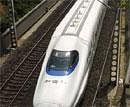
Airlines linking Beijing, Shanghai and other cities have been searching for ways to prevent passengers from flowing onto the new Beijing-Shanghai high-speed link that will start operation on June 30.
The measures include more discounts as well as free to and fro airport shuttle buses, state run China Daily reported.
The1,318-kilometer Beijing-Shanghai high speed rail will bring down the travel time from 10 hours to five hours, which is more or less the same in case of air travel if one includes the check-in time.
The cheapest air ticket from Beijing to Shanghai now costs 368 yuan (USD 72) less, or a 67 per cent discount on the full ticket price.
The lowest air fare is now less than the high-speed bullet train's cheapest second-class seat ticket -- 410 yuan.
"Many passengers would like to try the train ride. The new line is sure to drive many passengers from airplanes to trains in the short-term, which will lead to a decrease in air ticket prices," Qunar.com Senior Director Air Tickets Business Department Yang Wei was quoted as saying in the report.
He added that airlines will cut prices and offer more discounts to meet the fierce competition from bullet trains.
"In addition, airlines are likely to cut or suspend carriers linking cities along the rail line, especially on short routes linking Beijing and Jinan or Jinan and Shanghai, due to less passenger flow," Yang said.
On March, flights between Wuhan and Nanjing were edged out after a high-speed line linking the two cities was put into operation, the report said.
Meanwhile, airports in cities along the Beijing-Shanghai high-speed railway are providing quicker check-in services and enabling closer ties with railway stations to further boost passenger flow.
The airport in Nanjing, capital of East China's Jiangsu province, has set up special check-in services for passengers heading to Beijing.
"Now for average passengers to Beijing, it only takes about five minutes to check in rather than the earlier 30 minutes," a staff member at the airport told the daily.
The influence of high-speed railway on airlines can be traced back to 2009, when the opening of the Wuhan-Guangzhou high-speed railway significantly reduced the number of flights between the two cities.
Bullet trains between Chengdu and Chongqing in Southwest China have eliminated flights between the two cities